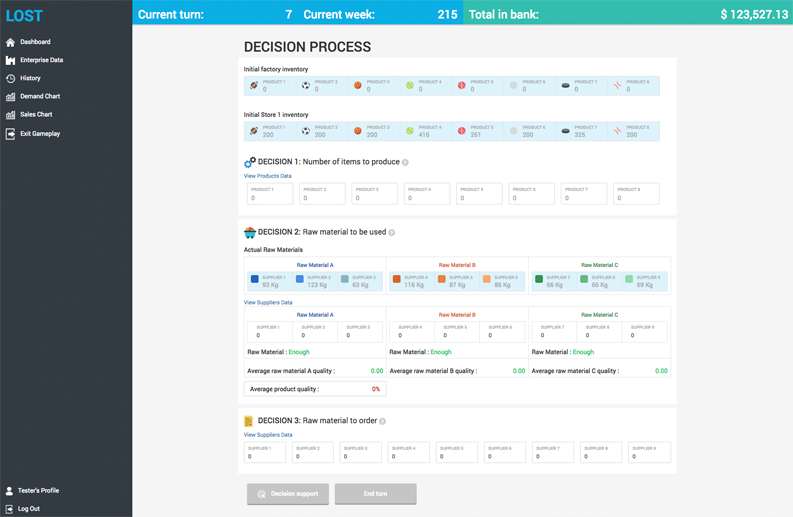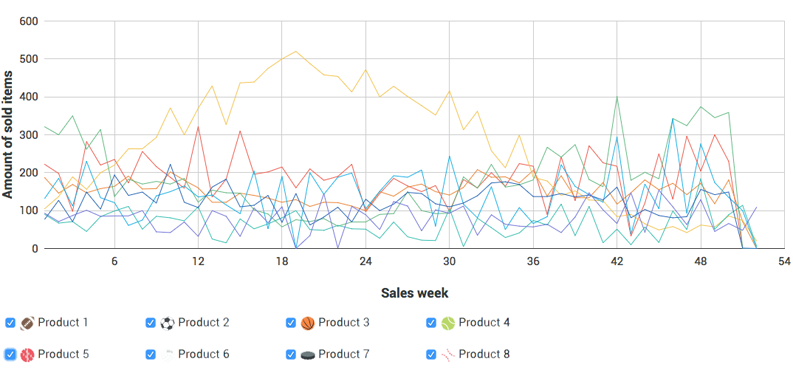LOST is a business game that allows students to acquire logistics concepts quickly and fun; and to develop an intrinsic motivation that leads them to reach, understand and experiment new strategies.
Logistics is defined as a business planning for the management of materials, services, information and capital flows. By other hand, a strategy game is a game in which players use their technical and planning skills, a tactical deployment and have a high situational awareness that allows them to make an optimal decision making in order to win the game.
Logistic Simulator (LOST) is a video game that allows to students to develop logistical concepts and understand its interfaces showing to people the consequences of each decision they make and indicating how a decision in one department affect the performance of the overall system.
Traditionally, one of the greatest difficulties in teaching logistics is that a huge majority of universities have organized their programs in such way that the knowledge they offer is functionally fragmented. Regularly there are specific areas where it is taught: forecasts, inventory, scheduling, etc. Moreover, these techniques and models require a high mathematical expertise, which for many students means an arid phase where it is difficult to assimilate the content.
Finally, even if the students have been able to overcome these difficulties and to distinguish production problems, inventory problems, optimization problems; when they facing the real world, they have trouble involving at the same time many of these functional areas and need to manage the interfaces between them.
LOST is a new vision for teaching logistics; it’s a business game that gradually increases its difficulty and allows students:
- To acquire logistics concepts quickly and fun
- To observe the consequences of each decision in different areas of a company
- To identify the main variables that must be observed when making every decision.
- To develop an intrinsic motivation that leads them to investigate, understand and experiment new strategies to reach the solution of a problem

PROJECT APPROACH
LOST is a video game based on a didactic technique called "gamification". The scenarios are defined by the teacher depending on the thematic content of the subject.
Through a video, an introduction to the game is presented to students where we narrate a problem faced by a company and we ask students to make decisions that help the company.
Once students have understood how to operate the program and goals of the company, each of them will receive a file with a set of data (demands, operating costs, delivery times, costs of raw materials, quality) that is randomly generated but has a homogeneous degree of difficulty. Based on these data, students must define a feasible production plan that allows their company achieve higher profits.
Before the students begin the game we asked them to define the strategy that they will follow during the game. Each of the decisions that the students make is transferred and stored in a database so we can observe the consistency between the decisions made and the defined strategy.
On the other hand, within the simulator there is a "trophy room" where we indicate to each student the challenges of the scenario. There is also a "leaderboard" that allows them to identify their performance against other group members.
When a student has achieved the goals successfully, a new scenario is given, containing new variables and regularly where he/she should take a greater number of decisions.
Regularly the teacher should review continuously the database to check the student progress, so when a student is away from the established goals, the teacher and the student discuss the possibility of changing the strategy or suggest adjustments about the operationalization of the decisions.

PROJECT ENGAGEMENT
As mentioned above, the game is based on a teaching technique called gamification. This technique allows students to achieve some awards and trophies throughout the game, and moreover, for a great majority of the students is very rewarding to see his/her name appearing at the top of the leaderboard.
The teacher regularly puts students a deadline to finish each game episode, during this period the students have the opportunity to play the game up to three times if the score obtained does not satisfy them, so that they can register again and try to improve their results. The highest score achieved is the one recorded in the standings.
Moreover, students also have a minimum target to beat. If any of the students do not reach the minimum score, then one of those who have achieved the highest scores will become his/her mentor to make sure he/she understands the key concepts of the game. For example, suppose that three of the students do not reach the minimum score, then the first three places on the leaderboard have the opportunity to be the "counselors" of these students, and this extra work allows them to obtain specific rewards along the course.
Although regularly at the first opportunity 70% of them exceeds the minimum overcome, 85% of them return to play in order to improve their score!!!
When they reach the goals, a new scenario is presented to them. All scenarios contain logistical problems related to topics such as forecasts, inventory, transportation, quality, production management, vendor selection, scheduling activities, etc., but the complexity of the situation faced by the student and goals achieve are increasingly high.
Additionally, although the different stages and episodes of the program are described to students, there is always a suggestion box to recommend new challenges, so that most of the improvements that we have made come from the opinions of the students themselves.

- The game helps me to learn: 48% strongly agree, 39% agree.
- The game helps me to develop interest in the subject: 61% strongly agree, 28% agree.
- The game prompts me to push myself: 64% strongly agree, 27% agree.
- The game helps me to build confidence in the mastery of the subject: 43% strongly agree, 42% agree.
- The game develops my persistence to solve a challenge: 55% strongly agree, 36% agree.
- The game helps me to demand more from myself: 60% strongly agree, 30% agree.
- The game does not bring me any benefit: 61% strongly disagree, 31% disagree.
- The game seems to me like a waste of time: 60% strongly disagree, 31% disagree.
- Based on this data and the change in attitude of the students to these courses, we believe the results are encouraging.
NEXT STEPS
Although we have designed twelve different scenarios for the game, there are currently only six programmed scenarios. In addition, the project wants to incorporate experts in the areas of finance, marketing and supply chain to help us think and design new challenges.
Moreover, the game is set on a platform with Excel VBA programming. We want to rebuild it in a more robust computer language that allows students to operate it from mobile devices (tablets and phones).
Likewise, we want to build a largely enough data base that allows us to observe what are the main mistakes that students make when playing the simulator; what variables they consider important; what variables pass them unnoticed; what are the more successful strategies; how they apply the previous knowledge; etc. Based on these results, one objective is to design a series of didactic supports (exercises, videos, readings) that offer useful advices that may strengthen their weaker skills.
In Mexico, small and medium enterprises (SMEs) generate 72% of employment and 52% of gross domestic product (GDP). We believe that putting the game on the network to develop logistics concepts in this type of business becomes an essential task that will contribute to the development of our country.
In addition to the survey applied to students at the end of each scenario, there is also another survey that allows us to identify general student characteristics (gender, career, semester, age, etc.). Through this type of survey we are able to develop a deeper research that allows us to explore the usefulness of the simulator on different types of students.
Finally, we want to put at least the first two scenarios on the network in order to allow the project to be available for both, students and teachers to use.